YOUNG CURATORS PROGRAM IN PINTA Sud | ASU 2024
The third edition of Pinta Sud | ASU featured for the first time the Young Curators Program, under the leadership of Adriana Almada. In a conversation with Arte al Día, the two selected participants -Majo Fiorio and Luis Ocampos Pompa- shared their experience throughout the process.
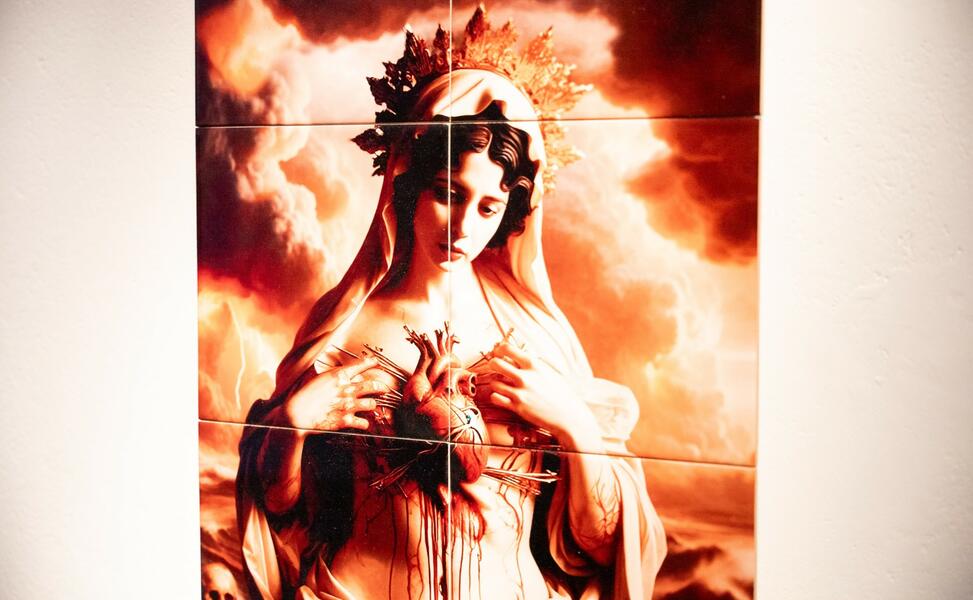
What is the Pinta Sud | ASU Young Curators Program about? What was your experience like?
Luis Ocampos Pompa: The Young Curators Program seeks to provide a space for young voices that are entering the scene of curatorial practices. The experience was very enriching.
Majo Fiorio: This program was presented as a platform to provide spaces for new voices and new looks. It was a challenging experience that implied taking into account the management of the space, the support of the production of the work, the expography, the installation, the design and the communication.
-
"Testimonios de lo indómito". Exhibición colectiva en Espacio E con la curaduría de Majo Fiorio.
-
"Testimonios de lo indómito". Exhibición colectiva en Espacio E con la curaduría de Majo Fiorio.
-
"Perseguir el sol: paisajes deseados para el fin del mundo". Exposición colectiva en La otra Casa de Asterión con la curaduría de Luis Ocampos Pompa
What aspects of the program do you consider most valuable for your professional development?
Majo Fiorio: I consider both Adriana Almada's accompaniment and the experience of working with the artists and the space invaluable. I emphasize the exchange of points of view between the work teams and the very collaborative approach that was outlined from the beginning. It is also worth mentioning the excellent organization on the part of Pinta Sud ASU, this initiative helped us to create bonds, to gain experience, to link pieces and to link us among peers.
Luis Ocampos Pompa: I consider that one of the most valuable aspects was to have worked closely with curators of long trajectory, who dedicated their time and experience to guide us in our proposals.
-
"Testimonios de lo indómito". Exhibición colectiva en Espacio E con la curaduría de Majo Fiorio.
-
"Testimonios de lo indómito". Exhibición colectiva en Espacio E con la curaduría de Majo Fiorio.
-
"Perseguir el sol: paisajes deseados para el fin del mundo". Exposición colectiva en La otra Casa de Asterión con la curaduría de Luis Ocampos Pompa
Could you describe the exhibitions you curated at Pinta Sud | ASU 2024 within the program? ("Testimonios de lo indómito". Group exhibition at Espacio E curated by Majo Fiorio and "Perseguir el sol: paisajes deseados para el fin del mundo". Group exhibition at La otra Casa de Asterión curated by Luis Ocampos Pompa)
Luis Ocampos Pompa: The exhibition "Perseguir el sol: paisajes deseados para el fin del mundo" (Chasing the sun: desired landscapes for the end of the world) brings together the work of three mid-career artists who are not yet sufficiently visibilized: Rudy Cáceres, Jonatan Fernández and Giovanni Ferreira. The theme of the exhibition revolves around the landscape, starting from the question of the emotional charge that is lodged in the gesture of contemplating it, in a present besieged by multiple expressions of violence and deterioration of natural environments. Each artist has worked on the basis of desires or doubts about the future of existence in the world, addressing issues such as pollution, the impact of plastic waste and a hypothetical end of the world.
Majo Fiorio: The exhibition is entitled "Testimonios de lo indómito" (Testimonies of the untamed). It brings together works by Belén Rodríguez, Leticia Alvarenga and Brune Poletti. The proposal is presented in the Erika Milée room of Espacio E; it approaches, from different media, ways of situating oneself before the state of the present. The artists start from issues related to problems that occur in the territory, their practices propose ways of conceiving art from their places of enunciation. This exhibition takes the works as contaminated testimonies that distort the structures and images preconceived by state and religious apparatuses.
-
"Testimonios de lo indómito". Exhibición colectiva en Espacio E con la curaduría de Majo Fiorio.
-
"Testimonios de lo indómito". Exhibición colectiva en Espacio E con la curaduría de Majo Fiorio.
-
"Perseguir el sol: paisajes deseados para el fin del mundo". Exposición colectiva en La otra Casa de Asterión con la curaduría de Luis Ocampos Pompa
How do you see the role of young curators in the promotion and dissemination of emerging art and how do these programs facilitate this task?
Luis Ocampos Pompa: At this particular moment, the Paraguayan art scene has diversified a lot and there are spaces that are interested in different proposals of works and also in young curatorial looks. However, I still notice a certain generational resistance when it comes to making room for new voices. This type of program allows us to get closer and talk to share our knowledge and views in an environment of respectful exchange.
Majo Fiorio: I see this role as something incisive when it comes to presenting proposals from other points of view. Young curators and emerging artists need to work together and generate a community, because from there the processes will be strengthened and will last over time. Programs of this kind facilitate the sharing of ideas between those who are starting out or making their first incursions and those who already have a long trajectory; they are fundamental and key formative spaces in our context, since there are not many opportunities like this one. The continuity of this type of initiatives will facilitate the dynamization of the artistic/cultural environment in the present and the future.
-
"Testimonios de lo indómito". Exhibición colectiva en Espacio E con la curaduría de Majo Fiorio.
-
"Testimonios de lo indómito". Exhibición colectiva en Espacio E con la curaduría de Majo Fiorio.
-
"Perseguir el sol: paisajes deseados para el fin del mundo". Exposición colectiva en La otra Casa de Asterión con la curaduría de Luis Ocampos Pompa
To what extent do you think that training and support for young curators can influence the evolution of cultural institutions and museums in the region?
Luis Ocampos Pompa: It can have a positive influence. Without romanticizing the new generations, young people certainly look with different eyes at what they have received from their predecessors. Those looks, accompanied by a correct orientation, can bring us closer to new ways of imagining the world and the systems that order it, including cultural systems.
Majo Fiorio: On the one hand, this will imply many changes and disputes between generational perspectives, which may entail effort in listening and relating; on the other hand, it could also generate a system that creates a synergy with diverse, multicultural and inclusive postures and reflections, a constant back and forth between the different concerns and conceptions of the key agents in these spaces.
Related Topics
May interest you

The third edition of Pinta Sud | ASU 2024 came to an end after a day of ceramic workshop in Itá with the renowned ceramist Julia Isídrez.
PINTA Sud | ASU CLOSED ITS THIRD EDITION AT JULIA ISÍDREZ'S WORKSHOP IN ITÁ
The third edition of Pinta Sud | ASU 2024 came to an end after a day of ceramic workshop in Itá with the renowned ceramist Julia Isídrez.

The third edition of Pinta Sud | ASU 2024 came to an end after a day of ceramic workshop in Itá with the renowned ceramist Julia Isídrez.
PINTA Sud | ASU CLOSED ITS THIRD EDITION AT JULIA ISÍDREZ'S WORKSHOP IN ITÁ
The third edition of Pinta Sud | ASU 2024 came to an end after a day of ceramic workshop in Itá with the renowned ceramist Julia Isídrez.

Nélida Mendoza is an artist who was born in Paraguay, but lived in several parts of the world, including Argentina and Italy. She is presenting the exhibition Fuerte Olimpo and Other Stories at the gallery K / Arte y Naturaleza during the Pinta Sud | ASU 2024 art week.
NÉLIDA MENDOZA'S IDENTITY SYSTEMS
Nélida Mendoza is an artist who was born in Paraguay, but lived in several parts of the world, including Argentina and Italy. She is presenting the exhibition Fuerte Olimpo and Other Stories at the gallery K / Arte y Naturaleza during the Pinta Sud | ASU 2024 art week.
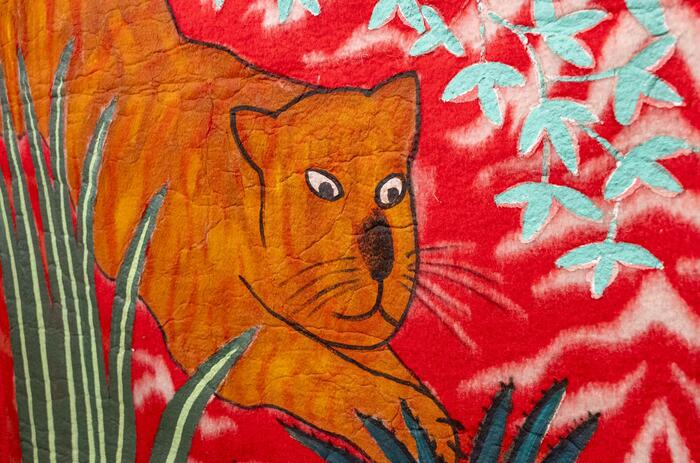
Pinta Sud | ASU 2024 presented at the Casa Mayor gallery the exhibition Warm Heart, with works by the Paraguayan artist Feliciano Centurión. It is a collection of works from different periods of his career and is curated by Irene Gelfman.
FELICIANO CENTURIÓN'S WARM HEART
Pinta Sud | ASU 2024 presented at the Casa Mayor gallery the exhibition Warm Heart, with works by the Paraguayan artist Feliciano Centurión. It is a collection of works from different periods of his career and is curated by Irene Gelfman.
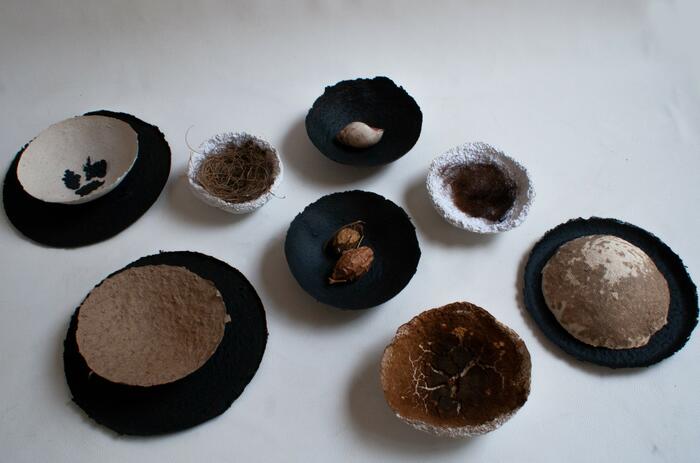
Gustavo Benítez presents at Exaedro the exhibition Damiana vuelve a casa (Damiana returns home), an exhibition that explores a story of identity, pain and abandonment. It is presented in the context of the art week Pinta Sud | ASU 2024, from August 5 to 11, and is curated by Ticio Escobar.
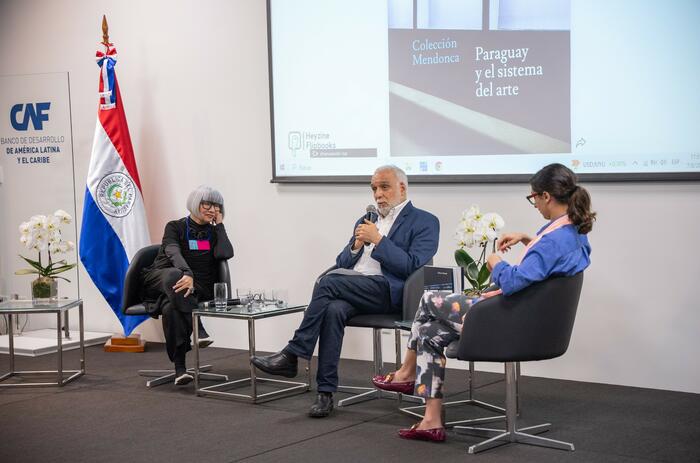
Within the framework of Pinta Sud | ASU 2024 FORO conversatory, Ticio Escobar - moderated by Irene Gelfman - participated in the exclusive presentation of the book "Colección Mendonca. Paraguay and the art system", by Adriana Almada. The book was presented at CAF - Development Bank of Latin America and the Caribbean.
PARAGUAY AND THE ART SYSTEM
Within the framework of Pinta Sud | ASU 2024 FORO conversatory, Ticio Escobar - moderated by Irene Gelfman - participated in the exclusive presentation of the book "Colección Mendonca. Paraguay and the art system", by Adriana Almada. The book was presented at CAF - Development Bank of Latin America and the Caribbean.
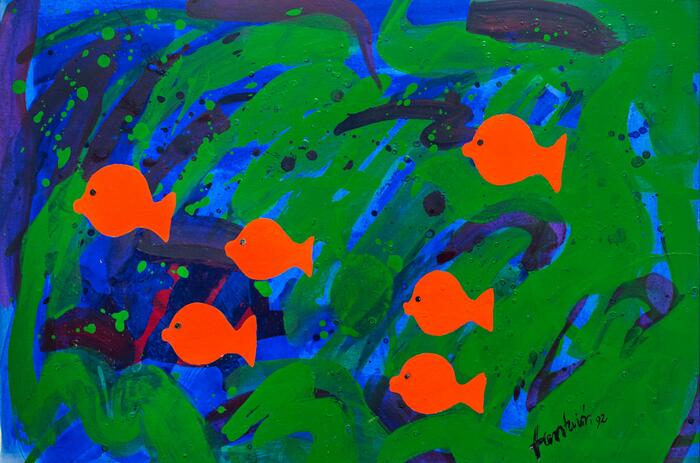
Paraguay is rarely mentioned when discussing the global art market, but this might change in the coming years due to its growing activity in the contemporary art sector. This activity is primarily driven by local galleries, which, aware of the cultural isolation the country has experienced for many years, are actively promoting local collecting and seeking to promote their artists through fairs and participation in events like the current Pinta Sud|ASU.
PARAGUAY: AN EXPANDING ART MARKET
Paraguay is rarely mentioned when discussing the global art market, but this might change in the coming years due to its growing activity in the contemporary art sector. This activity is primarily driven by local galleries, which, aware of the cultural isolation the country has experienced for many years, are actively promoting local collecting and seeking to promote their artists through fairs and participation in events like the current Pinta Sud|ASU.
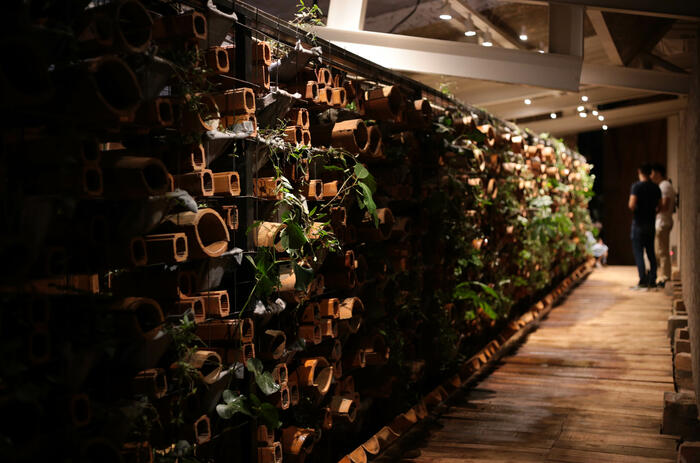
Fundación Texo presents the return of its most important and ambitious program, #Seleccion5. This initiative highlights the value of contemporary Paraguayan architecture, presenting an exhibition project of outstanding local studios and professionals.
TEXO FOUNDATION AND THE ARCHITECTURE PROJECT #SELECCION5
Fundación Texo presents the return of its most important and ambitious program, #Seleccion5. This initiative highlights the value of contemporary Paraguayan architecture, presenting an exhibition project of outstanding local studios and professionals.

Luciérnagas humanas al ras de la tierra (Human fireflies at ground level) is a video-installation that the artist Marcos Benítez presents at the Paraguayan-German Cultural Institute. It is curated by Adriana Almada and will be part of the art week of Asunción Pinta Sud | ASU 2024.
THE INSTALLATION OF MARCOS BENITEZ AT ICPA
Luciérnagas humanas al ras de la tierra (Human fireflies at ground level) is a video-installation that the artist Marcos Benítez presents at the Paraguayan-German Cultural Institute. It is curated by Adriana Almada and will be part of the art week of Asunción Pinta Sud | ASU 2024.
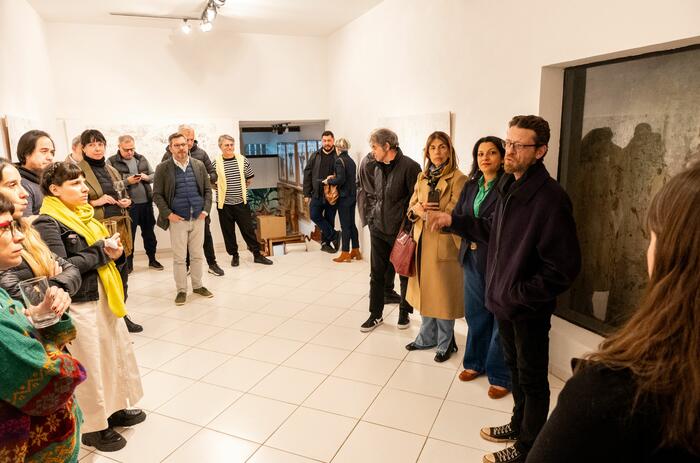
The third and last edition of Art Week Asuncion presented by Pinta Sud | ASU starts today August 5 with an ambitious cultural program, curated by Adriana Almada and accompanied by Irene Gelfman, featuring exhibitions, curatorial programs, lecture series and events.
PINTA Sud | ASU ART WEEK IN ASUNCION
The third and last edition of Art Week Asuncion presented by Pinta Sud | ASU starts today August 5 with an ambitious cultural program, curated by Adriana Almada and accompanied by Irene Gelfman, featuring exhibitions, curatorial programs, lecture series and events.

Last Thursday, September 26, a ceremony was held at the French Embassy in Paraguay, where Ambassador Pierre-Christian Soccoja awarded art critic Adriana Almada and visual artist Félix Toranzos with the Order of Arts and Letters. Both were part of the third edition of Pinta Sud | ASU.
ADRIANA ALMADA AND FÉLIX TORANZOS: AWARDED BY THE GOVERNMENT OF FRANCE
Last Thursday, September 26, a ceremony was held at the French Embassy in Paraguay, where Ambassador Pierre-Christian Soccoja awarded art critic Adriana Almada and visual artist Félix Toranzos with the Order of Arts and Letters. Both were part of the third edition of Pinta Sud | ASU.

The third edition of Pinta Sud | ASU 2024 came to an end after a day of ceramic workshop in Itá with the renowned ceramist Julia Isídrez.
PINTA Sud | ASU CLOSED ITS THIRD EDITION AT JULIA ISÍDREZ'S WORKSHOP IN ITÁ
The third edition of Pinta Sud | ASU 2024 came to an end after a day of ceramic workshop in Itá with the renowned ceramist Julia Isídrez.

Nélida Mendoza is an artist who was born in Paraguay, but lived in several parts of the world, including Argentina and Italy. She is presenting the exhibition Fuerte Olimpo and Other Stories at the gallery K / Arte y Naturaleza during the Pinta Sud | ASU 2024 art week.
NÉLIDA MENDOZA'S IDENTITY SYSTEMS
Nélida Mendoza is an artist who was born in Paraguay, but lived in several parts of the world, including Argentina and Italy. She is presenting the exhibition Fuerte Olimpo and Other Stories at the gallery K / Arte y Naturaleza during the Pinta Sud | ASU 2024 art week.

Pinta Sud | ASU 2024 presented at the Casa Mayor gallery the exhibition Warm Heart, with works by the Paraguayan artist Feliciano Centurión. It is a collection of works from different periods of his career and is curated by Irene Gelfman.
FELICIANO CENTURIÓN'S WARM HEART
Pinta Sud | ASU 2024 presented at the Casa Mayor gallery the exhibition Warm Heart, with works by the Paraguayan artist Feliciano Centurión. It is a collection of works from different periods of his career and is curated by Irene Gelfman.

Gustavo Benítez presents at Exaedro the exhibition Damiana vuelve a casa (Damiana returns home), an exhibition that explores a story of identity, pain and abandonment. It is presented in the context of the art week Pinta Sud | ASU 2024, from August 5 to 11, and is curated by Ticio Escobar.

Within the framework of Pinta Sud | ASU 2024 FORO conversatory, Ticio Escobar - moderated by Irene Gelfman - participated in the exclusive presentation of the book "Colección Mendonca. Paraguay and the art system", by Adriana Almada. The book was presented at CAF - Development Bank of Latin America and the Caribbean.
PARAGUAY AND THE ART SYSTEM
Within the framework of Pinta Sud | ASU 2024 FORO conversatory, Ticio Escobar - moderated by Irene Gelfman - participated in the exclusive presentation of the book "Colección Mendonca. Paraguay and the art system", by Adriana Almada. The book was presented at CAF - Development Bank of Latin America and the Caribbean.

Paraguay is rarely mentioned when discussing the global art market, but this might change in the coming years due to its growing activity in the contemporary art sector. This activity is primarily driven by local galleries, which, aware of the cultural isolation the country has experienced for many years, are actively promoting local collecting and seeking to promote their artists through fairs and participation in events like the current Pinta Sud|ASU.
PARAGUAY: AN EXPANDING ART MARKET
Paraguay is rarely mentioned when discussing the global art market, but this might change in the coming years due to its growing activity in the contemporary art sector. This activity is primarily driven by local galleries, which, aware of the cultural isolation the country has experienced for many years, are actively promoting local collecting and seeking to promote their artists through fairs and participation in events like the current Pinta Sud|ASU.

Fundación Texo presents the return of its most important and ambitious program, #Seleccion5. This initiative highlights the value of contemporary Paraguayan architecture, presenting an exhibition project of outstanding local studios and professionals.
TEXO FOUNDATION AND THE ARCHITECTURE PROJECT #SELECCION5
Fundación Texo presents the return of its most important and ambitious program, #Seleccion5. This initiative highlights the value of contemporary Paraguayan architecture, presenting an exhibition project of outstanding local studios and professionals.

Luciérnagas humanas al ras de la tierra (Human fireflies at ground level) is a video-installation that the artist Marcos Benítez presents at the Paraguayan-German Cultural Institute. It is curated by Adriana Almada and will be part of the art week of Asunción Pinta Sud | ASU 2024.
THE INSTALLATION OF MARCOS BENITEZ AT ICPA
Luciérnagas humanas al ras de la tierra (Human fireflies at ground level) is a video-installation that the artist Marcos Benítez presents at the Paraguayan-German Cultural Institute. It is curated by Adriana Almada and will be part of the art week of Asunción Pinta Sud | ASU 2024.

The third and last edition of Art Week Asuncion presented by Pinta Sud | ASU starts today August 5 with an ambitious cultural program, curated by Adriana Almada and accompanied by Irene Gelfman, featuring exhibitions, curatorial programs, lecture series and events.
PINTA Sud | ASU ART WEEK IN ASUNCION
The third and last edition of Art Week Asuncion presented by Pinta Sud | ASU starts today August 5 with an ambitious cultural program, curated by Adriana Almada and accompanied by Irene Gelfman, featuring exhibitions, curatorial programs, lecture series and events.

Last Thursday, September 26, a ceremony was held at the French Embassy in Paraguay, where Ambassador Pierre-Christian Soccoja awarded art critic Adriana Almada and visual artist Félix Toranzos with the Order of Arts and Letters. Both were part of the third edition of Pinta Sud | ASU.
ADRIANA ALMADA AND FÉLIX TORANZOS: AWARDED BY THE GOVERNMENT OF FRANCE
Last Thursday, September 26, a ceremony was held at the French Embassy in Paraguay, where Ambassador Pierre-Christian Soccoja awarded art critic Adriana Almada and visual artist Félix Toranzos with the Order of Arts and Letters. Both were part of the third edition of Pinta Sud | ASU.

The third edition of Pinta Sud | ASU 2024 came to an end after a day of ceramic workshop in Itá with the renowned ceramist Julia Isídrez.
PINTA Sud | ASU CLOSED ITS THIRD EDITION AT JULIA ISÍDREZ'S WORKSHOP IN ITÁ
The third edition of Pinta Sud | ASU 2024 came to an end after a day of ceramic workshop in Itá with the renowned ceramist Julia Isídrez.

Nélida Mendoza is an artist who was born in Paraguay, but lived in several parts of the world, including Argentina and Italy. She is presenting the exhibition Fuerte Olimpo and Other Stories at the gallery K / Arte y Naturaleza during the Pinta Sud | ASU 2024 art week.
NÉLIDA MENDOZA'S IDENTITY SYSTEMS
Nélida Mendoza is an artist who was born in Paraguay, but lived in several parts of the world, including Argentina and Italy. She is presenting the exhibition Fuerte Olimpo and Other Stories at the gallery K / Arte y Naturaleza during the Pinta Sud | ASU 2024 art week.

Pinta Sud | ASU 2024 presented at the Casa Mayor gallery the exhibition Warm Heart, with works by the Paraguayan artist Feliciano Centurión. It is a collection of works from different periods of his career and is curated by Irene Gelfman.
FELICIANO CENTURIÓN'S WARM HEART
Pinta Sud | ASU 2024 presented at the Casa Mayor gallery the exhibition Warm Heart, with works by the Paraguayan artist Feliciano Centurión. It is a collection of works from different periods of his career and is curated by Irene Gelfman.

Gustavo Benítez presents at Exaedro the exhibition Damiana vuelve a casa (Damiana returns home), an exhibition that explores a story of identity, pain and abandonment. It is presented in the context of the art week Pinta Sud | ASU 2024, from August 5 to 11, and is curated by Ticio Escobar.

Within the framework of Pinta Sud | ASU 2024 FORO conversatory, Ticio Escobar - moderated by Irene Gelfman - participated in the exclusive presentation of the book "Colección Mendonca. Paraguay and the art system", by Adriana Almada. The book was presented at CAF - Development Bank of Latin America and the Caribbean.
PARAGUAY AND THE ART SYSTEM
Within the framework of Pinta Sud | ASU 2024 FORO conversatory, Ticio Escobar - moderated by Irene Gelfman - participated in the exclusive presentation of the book "Colección Mendonca. Paraguay and the art system", by Adriana Almada. The book was presented at CAF - Development Bank of Latin America and the Caribbean.

Paraguay is rarely mentioned when discussing the global art market, but this might change in the coming years due to its growing activity in the contemporary art sector. This activity is primarily driven by local galleries, which, aware of the cultural isolation the country has experienced for many years, are actively promoting local collecting and seeking to promote their artists through fairs and participation in events like the current Pinta Sud|ASU.
PARAGUAY: AN EXPANDING ART MARKET
Paraguay is rarely mentioned when discussing the global art market, but this might change in the coming years due to its growing activity in the contemporary art sector. This activity is primarily driven by local galleries, which, aware of the cultural isolation the country has experienced for many years, are actively promoting local collecting and seeking to promote their artists through fairs and participation in events like the current Pinta Sud|ASU.

Fundación Texo presents the return of its most important and ambitious program, #Seleccion5. This initiative highlights the value of contemporary Paraguayan architecture, presenting an exhibition project of outstanding local studios and professionals.
TEXO FOUNDATION AND THE ARCHITECTURE PROJECT #SELECCION5
Fundación Texo presents the return of its most important and ambitious program, #Seleccion5. This initiative highlights the value of contemporary Paraguayan architecture, presenting an exhibition project of outstanding local studios and professionals.

Luciérnagas humanas al ras de la tierra (Human fireflies at ground level) is a video-installation that the artist Marcos Benítez presents at the Paraguayan-German Cultural Institute. It is curated by Adriana Almada and will be part of the art week of Asunción Pinta Sud | ASU 2024.
THE INSTALLATION OF MARCOS BENITEZ AT ICPA
Luciérnagas humanas al ras de la tierra (Human fireflies at ground level) is a video-installation that the artist Marcos Benítez presents at the Paraguayan-German Cultural Institute. It is curated by Adriana Almada and will be part of the art week of Asunción Pinta Sud | ASU 2024.

The third and last edition of Art Week Asuncion presented by Pinta Sud | ASU starts today August 5 with an ambitious cultural program, curated by Adriana Almada and accompanied by Irene Gelfman, featuring exhibitions, curatorial programs, lecture series and events.
PINTA Sud | ASU ART WEEK IN ASUNCION
The third and last edition of Art Week Asuncion presented by Pinta Sud | ASU starts today August 5 with an ambitious cultural program, curated by Adriana Almada and accompanied by Irene Gelfman, featuring exhibitions, curatorial programs, lecture series and events.

Last Thursday, September 26, a ceremony was held at the French Embassy in Paraguay, where Ambassador Pierre-Christian Soccoja awarded art critic Adriana Almada and visual artist Félix Toranzos with the Order of Arts and Letters. Both were part of the third edition of Pinta Sud | ASU.
ADRIANA ALMADA AND FÉLIX TORANZOS: AWARDED BY THE GOVERNMENT OF FRANCE
Last Thursday, September 26, a ceremony was held at the French Embassy in Paraguay, where Ambassador Pierre-Christian Soccoja awarded art critic Adriana Almada and visual artist Félix Toranzos with the Order of Arts and Letters. Both were part of the third edition of Pinta Sud | ASU.

The third edition of Pinta Sud | ASU 2024 came to an end after a day of ceramic workshop in Itá with the renowned ceramist Julia Isídrez.
PINTA Sud | ASU CLOSED ITS THIRD EDITION AT JULIA ISÍDREZ'S WORKSHOP IN ITÁ
The third edition of Pinta Sud | ASU 2024 came to an end after a day of ceramic workshop in Itá with the renowned ceramist Julia Isídrez.

Nélida Mendoza is an artist who was born in Paraguay, but lived in several parts of the world, including Argentina and Italy. She is presenting the exhibition Fuerte Olimpo and Other Stories at the gallery K / Arte y Naturaleza during the Pinta Sud | ASU 2024 art week.
NÉLIDA MENDOZA'S IDENTITY SYSTEMS
Nélida Mendoza is an artist who was born in Paraguay, but lived in several parts of the world, including Argentina and Italy. She is presenting the exhibition Fuerte Olimpo and Other Stories at the gallery K / Arte y Naturaleza during the Pinta Sud | ASU 2024 art week.

Pinta Sud | ASU 2024 presented at the Casa Mayor gallery the exhibition Warm Heart, with works by the Paraguayan artist Feliciano Centurión. It is a collection of works from different periods of his career and is curated by Irene Gelfman.
FELICIANO CENTURIÓN'S WARM HEART
Pinta Sud | ASU 2024 presented at the Casa Mayor gallery the exhibition Warm Heart, with works by the Paraguayan artist Feliciano Centurión. It is a collection of works from different periods of his career and is curated by Irene Gelfman.

Gustavo Benítez presents at Exaedro the exhibition Damiana vuelve a casa (Damiana returns home), an exhibition that explores a story of identity, pain and abandonment. It is presented in the context of the art week Pinta Sud | ASU 2024, from August 5 to 11, and is curated by Ticio Escobar.

Within the framework of Pinta Sud | ASU 2024 FORO conversatory, Ticio Escobar - moderated by Irene Gelfman - participated in the exclusive presentation of the book "Colección Mendonca. Paraguay and the art system", by Adriana Almada. The book was presented at CAF - Development Bank of Latin America and the Caribbean.
PARAGUAY AND THE ART SYSTEM
Within the framework of Pinta Sud | ASU 2024 FORO conversatory, Ticio Escobar - moderated by Irene Gelfman - participated in the exclusive presentation of the book "Colección Mendonca. Paraguay and the art system", by Adriana Almada. The book was presented at CAF - Development Bank of Latin America and the Caribbean.

Paraguay is rarely mentioned when discussing the global art market, but this might change in the coming years due to its growing activity in the contemporary art sector. This activity is primarily driven by local galleries, which, aware of the cultural isolation the country has experienced for many years, are actively promoting local collecting and seeking to promote their artists through fairs and participation in events like the current Pinta Sud|ASU.
PARAGUAY: AN EXPANDING ART MARKET
Paraguay is rarely mentioned when discussing the global art market, but this might change in the coming years due to its growing activity in the contemporary art sector. This activity is primarily driven by local galleries, which, aware of the cultural isolation the country has experienced for many years, are actively promoting local collecting and seeking to promote their artists through fairs and participation in events like the current Pinta Sud|ASU.

Fundación Texo presents the return of its most important and ambitious program, #Seleccion5. This initiative highlights the value of contemporary Paraguayan architecture, presenting an exhibition project of outstanding local studios and professionals.
TEXO FOUNDATION AND THE ARCHITECTURE PROJECT #SELECCION5
Fundación Texo presents the return of its most important and ambitious program, #Seleccion5. This initiative highlights the value of contemporary Paraguayan architecture, presenting an exhibition project of outstanding local studios and professionals.

Luciérnagas humanas al ras de la tierra (Human fireflies at ground level) is a video-installation that the artist Marcos Benítez presents at the Paraguayan-German Cultural Institute. It is curated by Adriana Almada and will be part of the art week of Asunción Pinta Sud | ASU 2024.
THE INSTALLATION OF MARCOS BENITEZ AT ICPA
Luciérnagas humanas al ras de la tierra (Human fireflies at ground level) is a video-installation that the artist Marcos Benítez presents at the Paraguayan-German Cultural Institute. It is curated by Adriana Almada and will be part of the art week of Asunción Pinta Sud | ASU 2024.

The third and last edition of Art Week Asuncion presented by Pinta Sud | ASU starts today August 5 with an ambitious cultural program, curated by Adriana Almada and accompanied by Irene Gelfman, featuring exhibitions, curatorial programs, lecture series and events.
PINTA Sud | ASU ART WEEK IN ASUNCION
The third and last edition of Art Week Asuncion presented by Pinta Sud | ASU starts today August 5 with an ambitious cultural program, curated by Adriana Almada and accompanied by Irene Gelfman, featuring exhibitions, curatorial programs, lecture series and events.

Last Thursday, September 26, a ceremony was held at the French Embassy in Paraguay, where Ambassador Pierre-Christian Soccoja awarded art critic Adriana Almada and visual artist Félix Toranzos with the Order of Arts and Letters. Both were part of the third edition of Pinta Sud | ASU.
ADRIANA ALMADA AND FÉLIX TORANZOS: AWARDED BY THE GOVERNMENT OF FRANCE
Last Thursday, September 26, a ceremony was held at the French Embassy in Paraguay, where Ambassador Pierre-Christian Soccoja awarded art critic Adriana Almada and visual artist Félix Toranzos with the Order of Arts and Letters. Both were part of the third edition of Pinta Sud | ASU.

The third edition of Pinta Sud | ASU 2024 came to an end after a day of ceramic workshop in Itá with the renowned ceramist Julia Isídrez.
PINTA Sud | ASU CLOSED ITS THIRD EDITION AT JULIA ISÍDREZ'S WORKSHOP IN ITÁ
The third edition of Pinta Sud | ASU 2024 came to an end after a day of ceramic workshop in Itá with the renowned ceramist Julia Isídrez.

Nélida Mendoza is an artist who was born in Paraguay, but lived in several parts of the world, including Argentina and Italy. She is presenting the exhibition Fuerte Olimpo and Other Stories at the gallery K / Arte y Naturaleza during the Pinta Sud | ASU 2024 art week.
NÉLIDA MENDOZA'S IDENTITY SYSTEMS
Nélida Mendoza is an artist who was born in Paraguay, but lived in several parts of the world, including Argentina and Italy. She is presenting the exhibition Fuerte Olimpo and Other Stories at the gallery K / Arte y Naturaleza during the Pinta Sud | ASU 2024 art week.

Pinta Sud | ASU 2024 presented at the Casa Mayor gallery the exhibition Warm Heart, with works by the Paraguayan artist Feliciano Centurión. It is a collection of works from different periods of his career and is curated by Irene Gelfman.
FELICIANO CENTURIÓN'S WARM HEART
Pinta Sud | ASU 2024 presented at the Casa Mayor gallery the exhibition Warm Heart, with works by the Paraguayan artist Feliciano Centurión. It is a collection of works from different periods of his career and is curated by Irene Gelfman.

Gustavo Benítez presents at Exaedro the exhibition Damiana vuelve a casa (Damiana returns home), an exhibition that explores a story of identity, pain and abandonment. It is presented in the context of the art week Pinta Sud | ASU 2024, from August 5 to 11, and is curated by Ticio Escobar.

Within the framework of Pinta Sud | ASU 2024 FORO conversatory, Ticio Escobar - moderated by Irene Gelfman - participated in the exclusive presentation of the book "Colección Mendonca. Paraguay and the art system", by Adriana Almada. The book was presented at CAF - Development Bank of Latin America and the Caribbean.
PARAGUAY AND THE ART SYSTEM
Within the framework of Pinta Sud | ASU 2024 FORO conversatory, Ticio Escobar - moderated by Irene Gelfman - participated in the exclusive presentation of the book "Colección Mendonca. Paraguay and the art system", by Adriana Almada. The book was presented at CAF - Development Bank of Latin America and the Caribbean.

Paraguay is rarely mentioned when discussing the global art market, but this might change in the coming years due to its growing activity in the contemporary art sector. This activity is primarily driven by local galleries, which, aware of the cultural isolation the country has experienced for many years, are actively promoting local collecting and seeking to promote their artists through fairs and participation in events like the current Pinta Sud|ASU.
PARAGUAY: AN EXPANDING ART MARKET
Paraguay is rarely mentioned when discussing the global art market, but this might change in the coming years due to its growing activity in the contemporary art sector. This activity is primarily driven by local galleries, which, aware of the cultural isolation the country has experienced for many years, are actively promoting local collecting and seeking to promote their artists through fairs and participation in events like the current Pinta Sud|ASU.

Fundación Texo presents the return of its most important and ambitious program, #Seleccion5. This initiative highlights the value of contemporary Paraguayan architecture, presenting an exhibition project of outstanding local studios and professionals.
TEXO FOUNDATION AND THE ARCHITECTURE PROJECT #SELECCION5
Fundación Texo presents the return of its most important and ambitious program, #Seleccion5. This initiative highlights the value of contemporary Paraguayan architecture, presenting an exhibition project of outstanding local studios and professionals.

Luciérnagas humanas al ras de la tierra (Human fireflies at ground level) is a video-installation that the artist Marcos Benítez presents at the Paraguayan-German Cultural Institute. It is curated by Adriana Almada and will be part of the art week of Asunción Pinta Sud | ASU 2024.
THE INSTALLATION OF MARCOS BENITEZ AT ICPA
Luciérnagas humanas al ras de la tierra (Human fireflies at ground level) is a video-installation that the artist Marcos Benítez presents at the Paraguayan-German Cultural Institute. It is curated by Adriana Almada and will be part of the art week of Asunción Pinta Sud | ASU 2024.

The third and last edition of Art Week Asuncion presented by Pinta Sud | ASU starts today August 5 with an ambitious cultural program, curated by Adriana Almada and accompanied by Irene Gelfman, featuring exhibitions, curatorial programs, lecture series and events.
PINTA Sud | ASU ART WEEK IN ASUNCION
The third and last edition of Art Week Asuncion presented by Pinta Sud | ASU starts today August 5 with an ambitious cultural program, curated by Adriana Almada and accompanied by Irene Gelfman, featuring exhibitions, curatorial programs, lecture series and events.

Last Thursday, September 26, a ceremony was held at the French Embassy in Paraguay, where Ambassador Pierre-Christian Soccoja awarded art critic Adriana Almada and visual artist Félix Toranzos with the Order of Arts and Letters. Both were part of the third edition of Pinta Sud | ASU.
ADRIANA ALMADA AND FÉLIX TORANZOS: AWARDED BY THE GOVERNMENT OF FRANCE
Last Thursday, September 26, a ceremony was held at the French Embassy in Paraguay, where Ambassador Pierre-Christian Soccoja awarded art critic Adriana Almada and visual artist Félix Toranzos with the Order of Arts and Letters. Both were part of the third edition of Pinta Sud | ASU.


